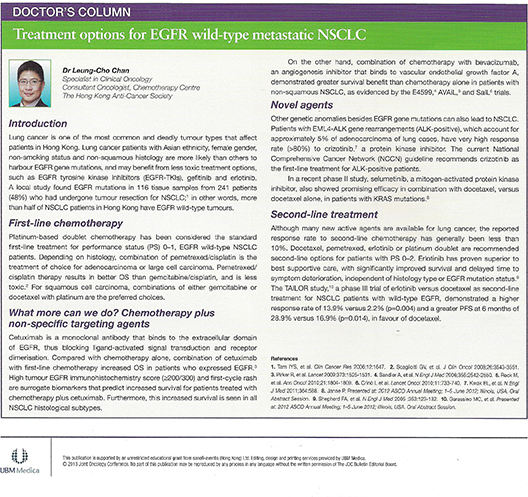Lung cancer is one of the most common and deadly tumour types that affect patients in Hong Kong. Lung cancer patients with Asian ethnicity, female gender, non-smoking status and non-squamous histology are more likely than others to harbor EGFR gene mutations, and may benefit from less toxic treatment options, such as EGFR tyrosine kinase inhibitors (EGFR-TKls), gefitinib and erlotinib. A local study gound EGFR mutations in 116 tissue samples from 241 patients (48%) who had undergone tumour resection for NSCLC;¹ in other words, more than half of NSCLC patients in Hong Kong have EGFR wild-type tumours.
Platinum-based doublet chemotherapy has been considered the standard first-line treatment for performance status (PS) 0-1, EGFR wild-type NSCLC patients. Depending on histology, combination of pemetrexed/cisplatin is the treatment of choice for adenocarcinoma or large cell carcinoma. Pemetrexed/cisplatin therapy results in better OS than gemcitabine/cisplatin, and is less toxic.²For squamous cell carcinoma, combinations of either gemcitabine or docetaxel with platinum are the preferred choices.
Cetuximab is a monoclonal antibody that binds to the extracellular domain of EGFR, thus blocking ligand-activated signal transduction and receptor dimerization. Compared with chemotherapy alone, combination of cetuximab with first-line chemotherapy increased OS in patients who expressed EGFR.³ High tumour EGFR immunohistochemistry score (≥200-300) and first-cycle rash are surrogate biomarkers that predict increased survival for patients treated with chemotherapy plus cetuximab. Furthermore, this increased survival is seen in all NSCLC histological subtypes.
On the other hand, combination of chemotherapy with bevacizumab, and angiogenesis inhibitor that binds to vascular endothelial growth factor A, demonstrated greater survival benefit than chemotherapy alone in patients with non-squamous NSCLC, as evidenced by the E4599,⁴ AVAiL⁵ and SaiL⁶ trials.
Other genetic anomalies besides EGFR gene mutations can also lead to NSCLC. Patients with EML4-ALK gene rearrangements (ALK-positive), which account for approximately 5% of adenocarcinoma of lung cases, have very high response rate (>80%) to crizotinib,⁷ a protein kinase inhibitor. The current National Comprehensive Cancer Network (NCCN) guideline recommends crizotinib as the first-line treatment for ALK-positive patients.
In a recent phase II study, selimetinib, a mitogen-activated protein kinase inhibitor, also showed promising efficacy in combination with docetaxel, versus docetaxel alone, in patients with KRAS mutations.
Although many new active agents are available for lung cancer, the reported response rate to second-line chemotherapy has generally been less than 10%. Docetaxel, pemetrexed, erlotinib or platinum doublet are recommended second-line options for patients with PS 0-2. Eriotinib has proven superior to best supportive care, with significantly improved survival and delayed time to symptom deterioration, independent of histology type or EGFR mutation status.⁹ The TAILOR study,¹⁰ a phase III trial of erlotinib versus deocetaxel as second-line treatment for NSCLC patients with wild-type EGFR, demonstrated a higher response rate of 13.9% versus 2.2% (p=0.004) and a greater PFS at 6 months of 28.9% versus 16.9% (p=0.014) in favour of docetaxel.
